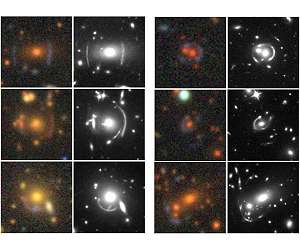
Like crystal balls for the universe's deeper mysteries, galaxies and other massive space objects can serve as lenses to more distant objects and phenomena along the same path, bending light in revelatory ways.
Gravitational lensing was first theorized by Albert Einstein more than 100 years ago to describe how light bends when it travels past massive objects like galaxies and galaxy clusters.
These lensing effects are typically described as weak or strong, and the strength of a lens relates to an object's position and mass and distance from the light source that is lensed. Strong lenses can have 100 billion times more mass than our sun, causing light from more distant objects in the same path to magnify and split, for example, into multiple images, or to appear as dramatic arcs or rings.
The major limitation of strong gravitational lenses has been their scarcity, with only several hundred confirmed since the first observation in 1979, but that's changing ... and fast.
A new study by an international team of scientists revealed 335 new strong lensing candidates based on a deep dive into data collected for a U.S. Department of Energy-supported telescope project in Arizona called the Dark Energy Spectroscopic Instrument (DESI). The study, published May 7 in The Astrophysical Journal, benefited from the winning machine-learning algorithm in an international science competition.
"Finding these objects is like finding telescopes that are the size of a galaxy," said David Schlegel, a senior scientist in Lawrence Berkeley National Laboratory's (Berkeley Lab's) Physics Division who participated in the study. "They're powerful probes of dark matter and dark energy."
These newly discovered gravitational lens candidates could provide specific markers for precisely measuring distances to galaxies in the ancient universe if supernovae are observed and precisely tracked and measured via these lenses, for example.
Strong lenses also provide a powerful window into the unseen universe of dark matter, which makes up about 85 percent of the matter in the universe, as most of the mass responsible for lensing effects is thought to be dark matter. Dark matter and the accelerating expansion of the universe, driven by dark energy, are among the biggest mysteries that physicists are working to solve.